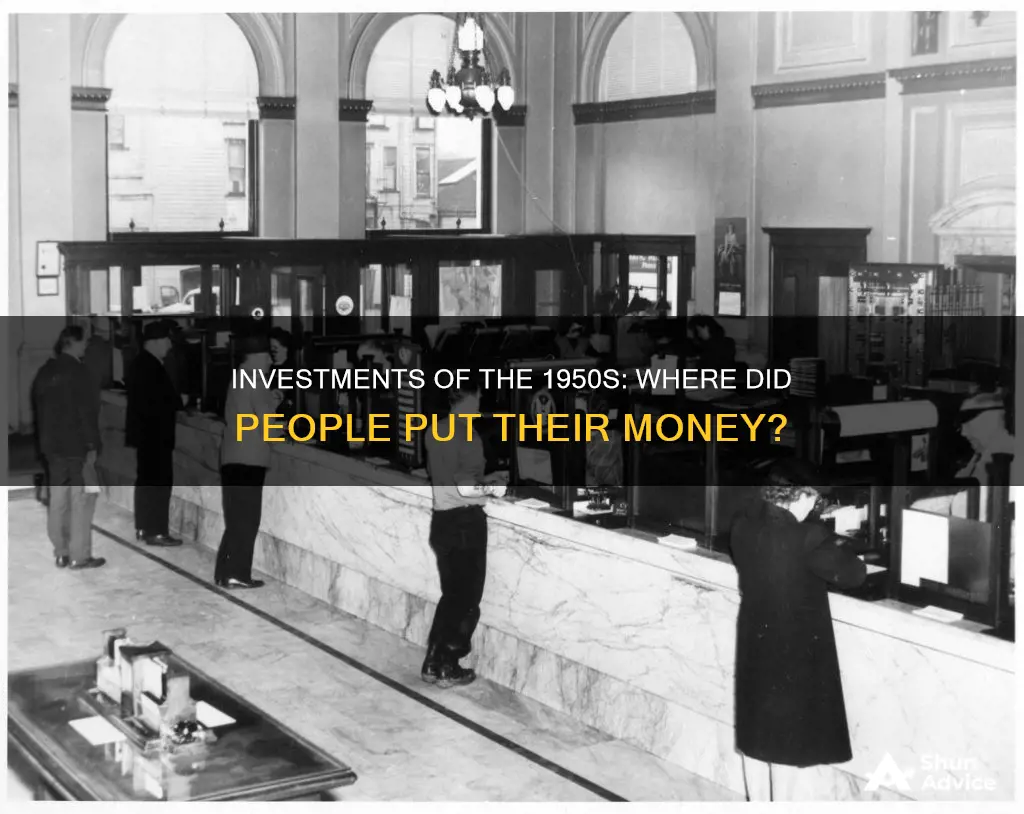
In the 1950s, the stock market was a very different world compared to today. The process of investing was more time-consuming and expensive, with fixed and high commission rates. Due to the impact of the 1929 market crash and the Great Depression, most people avoided investing in stocks. However, the 1950s saw a boom in European stocks during the post-war recovery, fuelled by significant investment from corporations and governments as Europe became more integrated. The concept of diversification in investment portfolios was also developed during this decade. Additionally, the uranium stock market experienced a surge due to the U.S.-Soviet nuclear arms race, though many of these stocks were worthless.
| Characteristics | Values |
|---|---|
| Number of Americans who owned common stock | 6.5 million (4.2% of the population) |
| Stock market accessibility | Less accessible |
| Markets liquidity | Less liquid |
| Investment process | More time-consuming and expensive |
| Stock brokerages | Independent entities |
| Commissions | Fixed, high, and non-negotiable |
| Investment choices | Limited |
| Mutual fund boom | Years away |
| Overseas investing | Non-existent |
| Stock prices | Difficult to obtain |
| NYSE daily trading volume | Below one million shares |
| NYSE monthly investment plan | $40 per month |
| Uranium stock boom | 1954 |
| European stocks | High returns |
What You'll Learn

Only 4.2% of Americans owned common stock
In the 1950s, the stock market was a vastly different world compared to today. A key reason why only 4.2% of Americans owned common stock during this period was the lingering trauma of the 1929 market crash and the subsequent Great Depression of the 1930s. It took 25 years for the Dow Jones Industrial Average (DJIA) to surpass its 1929 peak, which understandably made people wary of investing in stocks.
The process of investing in the 1950s was also more cumbersome and costly. The Glass-Steagall Act of 1933 prohibited commercial banks from operating on Wall Street, making stock brokerages separate entities. This lack of competition resulted in fixed, high, and non-negotiable commissions. The absence of modern technology also meant that executing stock trades took a significant amount of time, from initial contact with a broker to the final execution of the trade.
Limited investment options further contributed to the low percentage of Americans owning common stock. The mutual fund boom had not yet taken off, and the idea of investing overseas was non-existent. Obtaining active stock prices was challenging, often requiring direct communication with a stockbroker.
However, by the mid-1950s, things began to change. 1954 marked a turning point, with the NYSE introducing its monthly investment plan program, allowing individuals to invest as little as $40 per month. This initiative paved the way for the widespread adoption of stock investing among Americans in the following decades, particularly in the 1970s and 1980s.
Today, advancements in technology and communications have revolutionized the investment landscape, making it easier and more accessible for individuals to invest in the stock market. While stock ownership has increased over time, it is still not evenly distributed across demographic groups, with wealthier individuals holding a disproportionately larger share of stocks.
REITs: Recession-Proof Investment?
You may want to see also

The stock market was less accessible
In the 1950s, the stock market was less accessible than it is today.
According to the first shareowner census undertaken by the New York Stock Exchange (NYSE) in 1952, only 6.5 million Americans owned common stock (about 4.2% of the U.S. population). With a generation scarred by the market crash of 1929 and the Great Depression of the 1930s, most people in the 1950s stayed away from stocks. It was only in 1954 that the Dow Jones Industrial Average (DJIA) surpassed its 1929 peak, a full 25 years after the crash.
The process of investing was also more time-consuming and expensive in the 1950s than it is now. The execution of stock trades, from initial contact between an investor and a broker to the creation and execution of a trade ticket, took a considerable amount of time due to the limitations of technology. Fixed commissions were the norm, and limited competition meant that these commissions were quite high and non-negotiable.
The Glass-Steagall Act of 1933, which prohibited commercial banks from doing business on Wall Street, meant that stock brokerages were independent entities. This lack of competition allowed them to charge high prices.
Investment choices in the 1950s were also quite limited. The great mutual fund boom was still years away, and the concept of overseas investing was non-existent. Active stock prices were also somewhat difficult to obtain; an investor who wanted a current price quotation on a stock had few alternatives but to get in touch with a stockbroker.
However, by the mid-1950s, things were beginning to change. In 1953, the NYSE announced its monthly investment plan program, which allowed investors to invest as little as $40 per month. This development was the precursor to the monthly investment programs later marketed by most mutual funds, which led to the widespread adoption of stock investing among the U.S. population in the 1970s and 1980s.
In the 1950s, Europe also saw a boom in stocks during the post-war recovery, fuelled by significant investment from corporations and governments as Europe became more integrated.
Overall, while the stock market was less accessible in the 1950s than it is today, the decade still saw important developments that laid the foundation for the increasing popularity of stock investing in the years to come.
Impact Investing: Asian Youths' Perspective
You may want to see also

Mutual funds were yet to boom
In the 1950s, the investment landscape was vastly different from what it is today. The mutual fund industry was still in its infancy, and the concept of overseas investing was non-existent.
The first modern mutual fund was launched in the US in 1924, with the creation of the Massachusetts Investors Trust (MITTX). However, the mutual fund industry was dealt a significant blow by the stock market crash of 1929 and the subsequent Great Depression. It wasn't until after World War II, in the 1950s, that the industry started to pick up steam again. By 1951, there were over 100 mutual funds in operation, and more than 150 additional funds were created over the next two decades.
During the 1950s, the process of investing was time-consuming and expensive. Stock brokerages were independent entities due to the Glass-Steagall Act of 1933, which prohibited commercial banks from doing business on Wall Street. Fixed commissions were the norm, and limited competition meant that these commissions were high and non-negotiable. The lack of advanced technology also meant that executing stock trades took a considerable amount of time.
At the start of the 1950s, the number of open-end funds topped 100, and by 1954, the financial markets finally overcame their pre-1929 peak. This marked the beginning of significant growth for the mutual fund industry, with 50 new funds being added over the course of the decade.
While the mutual fund industry was growing, it had not yet reached the boom it would experience in the 1980s and 1990s. This boom was driven by the creation of retirement and tax vehicles such as Individual Retirement Accounts (IRAs) and 401(k) accounts, which replaced traditional pensions at many companies. As a result, money from investors of all sizes and backgrounds poured directly into mutual funds, making them a mainstream investment option.
In summary, while mutual funds were gaining traction in the 1950s, they had not yet reached the level of popularity and accessibility that they would achieve in subsequent decades. The industry was still relatively young and had to overcome various challenges, including the aftermath of the 1929 stock market crash and the limitations of the time-consuming and expensive investment process.
Rich People's Investment Strategies
You may want to see also

Overseas investing was non-existent
In the 1950s, the concept of investing overseas was non-existent. The post-war period saw a boom in European stocks, but this was largely driven by investment from corporations and governments within Europe, rather than from external sources.
The 1950s were a very different time for investing, with far fewer people choosing to put their money in stocks. In fact, according to a 1952 census by the New York Stock Exchange (NYSE), only 6.5 million Americans owned common stock, which was about 4.2% of the population. This was due in part to the generation's scarred memory of the 1929 market crash and the subsequent Great Depression of the 1930s. It wasn't until 1954 that the Dow Jones Industrial Average (DJIA) finally surpassed its 1929 peak.
The process of investing in the 1950s was also more time-consuming and expensive. The Glass-Steagall Act of 1933 prohibited commercial banks from doing business on Wall Street, meaning stock brokerages were independent entities. Fixed and high commission fees were the norm, and the limitations of technology meant that executing stock trades took a considerable amount of time.
The investment landscape of the 1950s was also much more limited. The mutual fund boom was yet to come, and active stock prices were difficult to obtain. An investor wanting a current price quotation on a stock had few options other than to contact a stockbroker.
However, by the mid-1950s, things were beginning to change. In 1953, the NYSE introduced its monthly investment plan program, which allowed investors to put in as little as $40 per month. This development marked the start of a shift towards the widespread adoption of stock investing among the US population in the following decades.
While the 1950s may have been a more insular time for investing, with little to no overseas investment, the decade laid the groundwork for the expansion of the stock market and the diversification of investment portfolios that we see today.
Amazon: Worth Your Investment?
You may want to see also

Stock trades were time-consuming and expensive
In the 1950s, stock trades were time-consuming and expensive. The process of investing was a lot slower than it is today due to the limitations of technology. The execution of stock trades, from initial contact between an investor and a broker to the creation and execution of a trade ticket, took a considerable amount of time.
The Glass-Steagall Act of 1933 prohibited commercial banks from doing business on Wall Street, meaning that stock brokerages were independent entities. This lack of competition led to fixed, high, and non-negotiable commissions, which added to the cost and time of trading.
The first shareowner census undertaken by the New York Stock Exchange (NYSE) in 1952 revealed that only 6.5 million Americans owned common stock, which was about 4.2% of the US population. A generation scarred by the market crash of 1929 and the Great Depression of the 1930s stayed away from stocks. It was not until 1954 that the Dow Jones Industrial Average (DJIA) surpassed its 1929 peak.
The great mutual fund boom was still years away, and the concept of overseas investing was non-existent. Active stock prices were difficult to obtain; investors had few alternatives but to contact a stockbroker for a current price quotation.
However, by the mid-1950s, things were beginning to change. In 1954, the NYSE announced its monthly investment plan program, allowing investors to invest as little as $40 per month. This development led to the widespread adoption of stock investing among the US population in the 1970s and 1980s.
Today, technological advancements have transformed the investment process, making it faster, more accessible, and more liquid. The proliferation of personal computers and the internet has put investors in control of their daily investing, and the popularity of online brokerages has driven down commissions.
Starbucks: Worth Your Investment?
You may want to see also
Frequently asked questions
In the 1950s, only 6.5 million Americans owned common stock, which was about 4.2% of the population. This was due to a generation being scarred by the market crash of 1929 and the Great Depression of the 1930s. Some people invested in uranium mine penny stocks, although many of these were worthless.
Many people had savings accounts, as securities were too expensive for the average person.
The process of investing was time-consuming and expensive. It was also difficult to obtain active stock prices.







